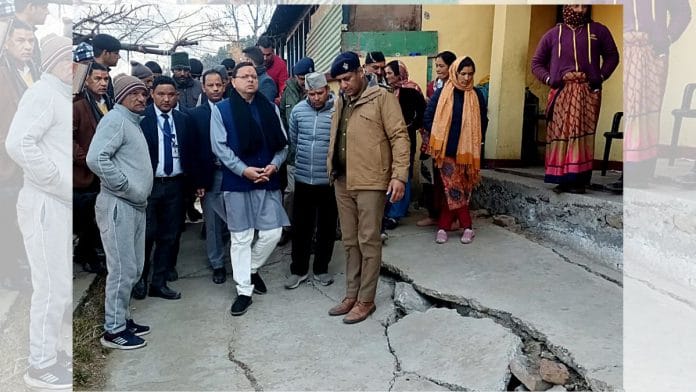For weeks now, a temple town in the state of Uttarakhand has been caving into itself. Between 28 December and 8 January, it caved by five whole centimeters to be precise, forcing roads and buildings to crack open.
In the past week or so, helpless residents of Joshimath have protested their sudden displacement after the cracks appeared, the precise cause for which is still being probed. Establishments that pose a danger to the structures around them will be demolished, and families rehabilitated.
Half-a-dozen teams of experts are trawling the landscape to ascertain what triggered the sudden subsidence in the town – a phenomenon whose warning signs were otherwise around for decades, reports show.
And as the town sinks, plans for its “development” have been suspended in mid air, as the need to revisit the idea of development in a fragile space gains urgency. And to address the larger question of sustainable development. The story of the temple town lies at the intersection of nature’s patience, chaotic development and the resultant displacement. That is why Joshimath is ThePrint’s Newsmaker of The Week.
Also read: Activists blame NTPC’s Tapovan power plant & govt’s Char Dham project for Joshimath sinking
What’s moving the ground beneath
What’s happening in Joshimath – land subsidence – is usually caused by movement underground, and its reasons can be linked to both natural and anthropogenic.
Joshimath lies in the highest seismic hazard Zone V, which means it is at high risk of facing earthquakes. The town was also built on landslide debris, and not on solid rock, making its foundation weak.
The risk of land subsidence to the area was first noted in a 1976 report by bureaucrat M.C. Mishra, who warned against the digging and blasting of rocks to build roads as well as unabated construction. It was also the first to point out that “Joshimath is a deposit of sand and stone — it is not the main rock — hence it was not suitable for a township. Vibrations produced by blasting, heavy traffic, etc., will lead to a disequilibrium in natural factors.”
But construction – of both houses, multi-story buildings and roads – has continued unabated in the town, whose population has swollen from around 400 in 1872 to around 25,000 today. During Char Dham ‘yatra season,’ the town hosts lakhs of pilgrims on their way to the four sacred shrines, stretching its resources thin.
Further adding pressure to the weak overburden is lack of proper drainage and sewerage systems that have likely caused water to seep into the soil, experts have said.
In 2009, while digging a tunnel for the NTPC’s hydro power plant, a tunnel boring machine got stuck and punctured a water bearing layer of rock, called an aquifer, which led to the loss of 700 litres of water per second.
In a 2010 paper titled Disaster looms over Joshimath, geologists had said the punctured aquifer and loss of water risked causing land subsidence over the town.
Also read: Army moves units from Joshimath to Auli, no impact on operations, says Army chief…
The projects
Two large developmental projects lie close to Joshimath. One is the NTPC thermal power project, which has been mired in controversy for decades. According to a TOI report, the Joshimath crisis marks the fifth time since the project’s inception in 2006 that it has come under the scanner.
Residents believe the tunneling of the project – which has used blasting techniques in the past – is the cause for their plight. In 2021, when an avalanche caused a deluge in the Dhauliganga river, water gushed into the tunnel. There are speculations that the rush of water further weakened the ground beneath Joshimath, however, a clear connection is yet to be established.
A second is the Char Dham road widening project, which involves expanding the existing roads by 10 meters so they can accommodate more cars and ease up traffic for pilgrims. Apart from the digging, felling of trees, and dumping of muck, the rise in traffic could also affect glaciers nearby, accelerating their decline. A bypass for the project, between Helang and Marwari, cuts across Joshimath.
Experts from a Supreme Court committee for the project have pointed out that not enough studies have been done to ascertain the stability of the mountains in these areas, which could add to the risk of subsidence.
Both projects were put on hold by the district administration on 5 January.
Also read: ‘Only place we’ve ever known’: As Joshimath crumbles, the displaced demand ‘fair compensation’
What residents want
Residents of the besieged town are demanding more compensation than what the government currently has on offer. Stripped of the roofs over their heads, they want Rs 5 lakh in interim relief, whereas the government has offered Rs 1.5 lakh – 1 lakh of which will be adjusted against rehabilitation.
After much resistance, residents are allowing their site of protest – two hotels on the verge of collapse – to be safely demolished by the administration to avoid further catastrophe.
“Death is inevitable, right? What is the point of leaving behind our homes, our lives, if it’s not for something fair? Better to die here, then,” said Sulojana Devi, who may never get to return.
(Edited by Anurag Chaubey)






